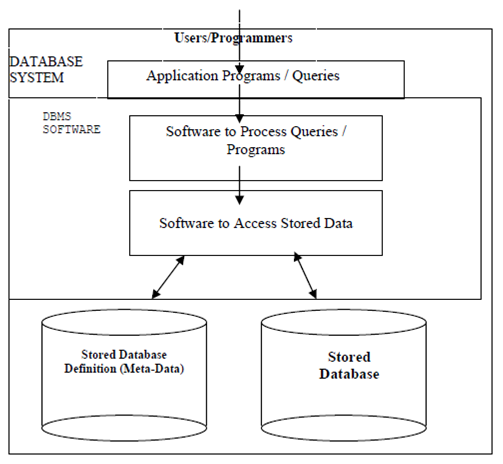Database system
Database technology and database are having a main impact on the growing use of computers. It is fair to say in which database will play a critical role in almost all areas where computers are used, involving business, medicine, engineering, education, law, and library science, to name a few. The term database is like general uses which we must starts through defining what a database is. Our first definition is quite common.
A database is a set of related data. Through data, we mean known facts which can be recorded and which have implicit meaning. For instance, consider telephone numbers, the names, and addresses of the people you know. You should have recorded this data in an indexed address book or you may have stored it on a diskette by using a personal computer and software such as PRADOX, or DBASE IV V, or EXCEL. This is a set of related data with an implicit meaning and therefore is a database.
The preceding definition of database is quite common; for instance, we may consider the collection of words which make up this page of text to be associated data and therefore to constitute a database. Therefore, the general use of the term database is commonly more restricted. A database has the subsequent implicit properties:
- A DB represents some aspect of the real world, sometimes known as the mini world or the UoD (Universe of Discourse), Changes to the miniworld are reflected in the database.
- A database is a logically coherent collection of data with some inherent meaning. A random assortment of data cannot rightly be referred-to as a database.
- A database is built, designed and populated with data for an exact purpose. It has an intended group of users and some preconceived application in which these users are interested.
In other terms a database has some source from that data are consequent some degree of communication with events in the real world and an audience which is actively interested in the contents of the database. The DB can be of any size and of varying complexity. For instance, the list of addresses and names referred to earlier should consist of only a few hundred records, every with a easy structure. Alternatively, the card catalog of a huge library should contain half a million cards stores under various categories-by primary author’s last name, by book title-with each category organized in alphabetic order by subject,. A database of even greater size and complexity is maintained through the Internal Revenue Service to keep track of the tax forms filed through taxpayers of the United States. If we suppose that there are 100 million taxpayers and if each taxpayer files an average of five forms with around 200 characters of information per type, we would get a database of 100*(10^6)*200*5 characters bytes of information. Supposing that the IRS keeps the past three returns for each taxpayer further to the current return we would obtain a database of 4*(10^11) bytes. This large amount of information must be organized and managed so that users can search for, retrieve, and update the data as required.
A database may be generate and maintained manually or through machine. The library card catalog is an instance of a database which may be manually maintained and created. A computerized database should be created and maintained either through a group of application programs written specifically for that task or through a database management system.
A DBMS (database management system) is a set of programs which enables users to establish and maintain a database. The database management system is hence a general-purpose software system which facilitates the processes of constructing, defining, and manipulating databases for several applications. Defining a database includes specifying the data types, structures and constraints for the data to be stored in the database. By Constructing the database is the process of storing the data itself on some storage medium which is controlled through the DBMS. Manipulating a database involves such functions as querying the database to retrieve specific data and updating the database to reflect changes in the miniworld and creating reports from the data.

It is not necessary to use general-purpose Data Base Management System software for implementing a computerized database. We might write our own set of programs to create and maintain the database in effect creating our own special-purpose DBMS or not-we commonly have to employ a considerable amount of software to manipulate the database further to the database itself and we will call the database and software together a database system.